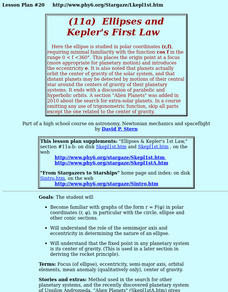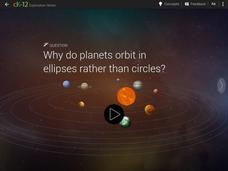Curated OER
Ellipses and Kepler's First Law
The class examines graphs in the form r = F(¿¿) in polar coordinates (r, ¿¿), in particular with the circle, ellipse and other conic sections. They determine the nature of an ellipse by studying the role of the semimajor axis and...
Curated OER
Earth Science Regents: The Ellipse
Starting with the instructions to draw an ellipse, and with great pictures, this sheet should help your pupils learn the shapes and measurements involved. Using push pins and string, your class can discover the axis and focus points...
Curated OER
Drawing Ellipses Lab
In this ellipse worksheet, students learn the difference between an orbit and an ellipse. They draw ellipses and calculate the distance between foci, they calculate the length of the major axis and they determine the eccentricity. They...
Curated OER
Ellipses
In this ellipses worksheet, students calculate the eccentricity of 5 given ellipses and show their calculations. Students then determine the percent deviation for their calculations using the accepted values of eccentricity.
University of Washington
Kepler’s Laws
Introduce your physics or astronomy class to Kepler's laws of planetary motion with this straightforward worksheet. It covers the basic concepts of each and has learners answer questions to demonstrate their grasp on them. You could use...
Curated OER
Ellipses
In this ellipses activity, students measure and calculate the eccentricity of each ellipse and then calculate the percent deviation. This activity has 10 problems to solve.
Curated OER
Planetary Orbit
Students compare and contrast ellipses of various eccentricities that represent the shape of planetary orbits. They make a circle with the string by trying the two ends togther. Students calculate the eccentricity of their ellipses by...
Curated OER
Ellipses And Kepler's First Law
Students explain that planets actually orbit the center of gravity of the solar system, and that distant planets may be detected by motions of their central star around the centers of gravity of their planetary systems.
CK-12 Foundation
Orbital Motion
Why do planets orbit the sun in ellipses when moons orbit their planet in circles? Pupils control the semi-major axis, eccentricity of the orbit, and position angle. The resulting orbital appears with the related force vectors as...
Curated OER
Planet Paths: Studying Planetary Orbital Paths
Students define and identify planetary orbit, ellipse, parabola, and hyperbola, and simulate Kepler's Second Law. They explore interactive websites demonstrating orbital motion and complete modeling activities.
Curated OER
Orbital Motion
Young scholars use a formula to measure the eccentricity of an ellipse, then state Kepler's Law of Elliptical Orbits. They predict the solar energy received at different positions in a planet's orbit.
Curated OER
Orbits Worksheet #1
A diagram of Earth's path around the sun, including the position of the moon, is displayed at the top of the worksheet. Five multiple questions get astronomers to analyze the diagram considering what is going on in the solar system. Use...
Curated OER
Bellwork for Week 19-Electromagnetic Spectrum and Planets
In this bellwork on the electromagnetic spectrum and planets learning exercise, learners answer questions about the information determined using a spectroscope, the geocentric and heliocentric models of planet rotation and the planets.
NASA
Nasa: Kepler and His Laws
This site from NASA provides biographical details about the lives of Tycho Brahe and Johannes Kepler. Discusses Kepler's successes at developing laws of planeatry motion. States the three laws and discusses each one individually....
Georgia State University
Georgia State University: Hyper Physics: Kepler's Laws
An outstanding page describing Kepler's three laws of planetary motion.
NASA
Nasa: Kepler's Second Law
This site from NASA states Kepler's second law of planetary motion and depicts its meaning with an informative diagram. Relates the law to conservation of energy principles and discusses the eccentricity of a satellite's (or a planet's)...
Other
Sandburg Center for Sky Awareness: What Are the Shapes of the Planets' Orbits?
In this lesson plan investigation pupils learn about the shapes of the planetary orbits by experimenting with ellipses of different proportions.
Cornell University
Cornell University: Astronomy: Orbital Motion and Kepler's Laws
At this site from the Astronomy Department of Cornell University, Kepler's three laws of planetary motion are stated. There are brief explanations of each, along with links to additional information on related subjects.

















